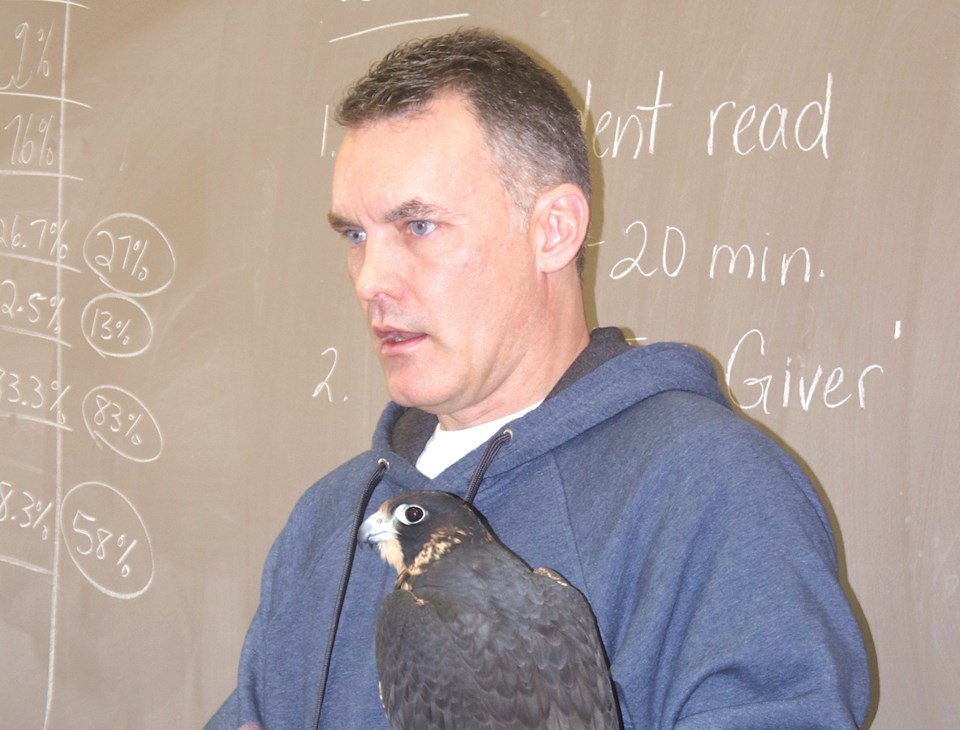For Dennis Tarr birds of prey have always drawn his interest.
“As a kid, just always seeing these birds, seeing them circling in the sky, they always kind of fascinated me,” he said.
That fascination would later draw Tarr to the sport of falconry, the hunting of wild animals in their natural state and habitat by means of a trained bird of prey.
Tarr said a couple of years ago he learned there was a falconer in the area so he contacted him.
“He said come on out and see my bird,” he said. “I was hooked.”
Tarr decided he wanted his own bird, but that is not a simple process. He had to first apprentice under an experienced falconer, a process that saw him live trapping a young red-tailed hawk.
For a year he learned the details of raising and training a bird of prey for hunting which he admitted has its challenges.
“They’re smart. They’re stubborn. They’re mean. They’ll fight you every step of the way until something clicks and they decide ‘you can spend time with me’,” said Tarr.
Hunting with the hawk was pretty straight forward once the bird was trained.
“I’d put her up in a tree,” he said adding that was a natural vantage point when red-tailed hawks hunt in the wild. It was then his job to walk around to rustle a rabbit or squirrel into moving, at which time the hawk would pounce.
At the end of the year with his hawk Tarr was required to return the bird to the wild. He said releasing his hawk was bittersweet having taught it to hunt and spending many hours with it in the year they were together.
But he was pragmatic about the release too. He noted generally “in the first year of life 80 per cent (of wild hawks) die.” He helped his hawk through that year releasing it in prime condition giving it a good chance to survive in the wild.
“It has a better chance than a wild bird,” he offered.
But, Tarr’s passion for the sport remained and he has since acquired a captive raised falcon from a breeder in Manitoba.
“He breeds the birds to be released into the wild,” explained Tarr, noting most of his birds are placed into wild nests when only a few days old to bolster wild populations, usually in Alberta.
As for the sport flying falcons is generally seen as the highest level of the sport, especially having a female falcon.
“Females are about a third bigger,” explained Tarr. “… The bigger they are, the tougher they are.” His falcon weighs in at about 1100 grams which is a rather large female.
Tarr said the difference between the red-tailed hawk and the falcon “was like hunting with a BB gun and going to a high-powered rifle.”
Hunting with the falcon is also different, at least in terms of how the bird goes about its business, and what the duo is hunting.
The falcon hunts from flight. Tarr said when his bird is released it climbs to about 1,000 feet and circles looking for a target.
The target is generally a duck, or small goose, again sent into the sky by Tarr’s effort to rustle one out.
“I flush up a duck and it (the falcon) dives and slams into it at 400 kilometres an hour.”
Tarr noted that when he and his falcon hunt ducks and geese he must hold a valid hunting licence and follow all the rules and regulations of the hunting season.
“It’s just instead of hunting with a gun I’m hunting with feathers and a beak,” he said with a smile.
During hunting season Tarr tries to get out with his bird daily, although as a paramedic in the city that is not always possible, especially as days grow shorter in the fall.
When there is no hunting season on, the falcon just hangs out in its mews, a birdhouse designed to house one or more birds of prey. The one for Tarr’s falcon is a 10X10 enclosure with an additional 10X12 area which gives his bird access to the outside.
“You keep them fat and happy,” said Tarr, adding you want them to have the best nutrition so when they undergo their annual moult, the shedding of mature feathers to grow new ones, they produce strong new plumage.
“The stronger the feathers, the better that they fly.”
Tarr said both his earlier hawk, and now falcon dine almost exclusively on quail he purchases from a producer in the province raising the birds for human consumption and eggs. The falcon will eat some of what it hunts but generally prefers the quail. He noted he was able to dine on a pheasant the falcon caught because it turned its beak up at consuming the upland bird.
As a falconer, Tarr is part of a rather exclusive group in Saskatchewan. The Saskatchewan Falconry Association was started in 1958 to promote the sport, with the Saskatchewan Falconers Club (SFC) created more recently focusing on the southern area of the province.
Tarr is a member of the SFC. He said while there are about a dozen members, only four currently have birds. He said others have shown interest, but having a bird is a major commitment of both money and time.
“They’re lots of work,” he said, again with a smile.
However, Tarr has no qualms about making the commitment himself.
“For me I like nature. I like being out in nature,” he said, adding he likes the solitude. “It’s calming. I have stressful work so it’s good to get out there (with his bird).”




